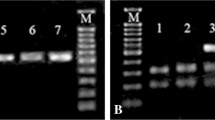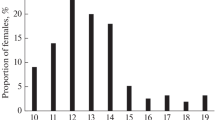Abstract
This study provides biological, fishery, and production characteristic of spawning females of a triple hybrid between the Russian sturgeon, Siberian sturgeon, and Amur sturgeon (RS × SS) × AS and other commercial hybrid sturgeon forms grown in the cages of a warm-water fish farm in Primorsky Krai, Russia. The survival rate of larvae and juveniles of the triple hybrid in conditions of warm-water pools and the survival rate of marketable-size sturgeon was higher than those of Amur sturgeon and hybrids between the Russian and Siberian sturgeons. The weights of the triple hybrid individuals at an age of 3 and 4 years were 1.58 and 2.36 kg, respectively. These values were higher than those recorded for the hybrids between Russian and Siberian sturgeons and close to the standard values for Amur sturgeon. The fish productivity reached 94 kg/m2 of cage, or 134 kg/m2 of cage taking fish that were sold into account. The values of this index were much higher than the standard values not only for Amur sturgeon, but also for other sturgeon species and hybrids. Up to 93% of the females reached maturity after being treated with a hormone-stimulating drug. The first female of the triple hybrid sturgeon became mature at an age of 9 years with a body weight of 13.1 kg. Maturation of the other females of the same year-class was stretched in time and lasted for 7 years, up to 16 years of age. Approximately 75% of them reached maturity at an age of 10–12 years. The maximum recorded weight of a female triple hybrid was 29 kg at an age of 14 years. The inter-spawning interval for 97% of females was 1–2 years. The average annual yield of hard roe obtained from one female at an age of 9–16 years per spawning event was 2.28 kg; the weight of one egg was 17.6 mg; the fecundity was 132 000 eggs; the relative working fecundity was 7440 eggs/kg; the oosomatic index was 12.8%. The values of most of the production indices for the female triple hybrids were intermediate between those characteristic of the initial species used for crossbreeding. For three or four spawning seasons, an average of 5.25 kg of hard roe, or 30% of body weight, was obtained from one female triple hybrid. The roe yield from the most productive females was 10.8–11.0 kg, or 55–73% of body weight. The roe of the triple hybrid sturgeon was distinguished by high quality and was used for manufacturing food products. Females were technologically well adapted for roe stripping and showed a high survival rate of approximately 98% during long-term exploitation. Thus, the triple hybrid of the Russian, Siberian, and Amur sturgeons can be recommended for commercial cultivation with a high production output at warm-water sturgeon farms. Female triple hybrids can be used for the production of quite large amounts of high-quality food caviar. Their roe yield is lower than that in Amur sturgeon and does not differ significantly from the roe yield in the hybrid between the Russian and Siberian sturgeons.


Similar content being viewed by others
REFERENCES
Burtsev, I.A., A method of obtaining roe from female fish, USSR Inventor’s Certificate no. 244793, Byull. Izobret., 1969, no. 18, p. 143.
Krylova, V.D., Biotechnology of commodity cultivation of bester and Lena sturgeon in a three-year cycle, in Rybnoye khozyaistvo, seriya: Vosproizvodstvo i pastbishchnoye vyrashchivaniye gidrobiontov: Analiticheskaya i referativnaya informatsiya. Vyp. 2 (Fish Farm, Ser.: Breeding and Ranching of Aquatic Organisms: Analytical and Reference Information, vol. 2), Moscow: VNIERKh, 2003.
Miburo Zachary, Use of hybridization of Russian sturgeon with Siberian species to increase output of marketable products, Cand. Sci. (Agric.) Dissertation, Samara, 2018.
Pravdin, I.F., Rukovodstvo po izucheniyu ryb (preimushchestvenno presnovodnykh) (Guide to the Study of Fish (Mainly Freshwater)), 4th ed., Moscow: Pishchepromizdsat, 1966.
Rachek, E.I., Amvrosov, D.Yu., Voropaev, V.M., et al., Razrabotka tekhnologii kombinirovannogo vyrashchivaniya dal’nevostochnykh osetrovykh v basseynakh i sadkakh teplovodnogo khozyaystva (Development of technology for the combined cultivation of Far Eastern sturgeons in pools and cages of a warm-water farm), Available from TINRO, 2005, Vladivostok, no. 25554.
Rachek, E.I., Current status of sturgeon farming in Primorsky Krai, Rybovod. Rybn. Khoz., 2012, no. 6, pp. 34–39.
Rachek, E.I. and Amvrosov, D.Yu., Characteristic of spawners for Amur sturgeon Acipenser schrenckii from warm-water cage farm in the process of long-term exploitation, Izv. Tikhookean. Nauchno-Issled. Inst. Rybn. Khoz. Okeanogr., 2018, vol. 192, pp. 202–213. https://doi.org/10.26428/1606-9919-2018-192-202-213
Rachek, E.I. and Svirsky, V.G., Process of the Amur sturgeon domestication in the warm-water farm of Primorye, Izv. Tikhookean. Nauchno-Issled. Inst. Rybn. Khoz. Okeanogr., 2008, vol. 155, pp. 219–229.
Rachek, E.I., Svirsky, V.G., and Skirin, V.I., Generative and somatic production of sturgeon females from experimental fish farm in Primorye as the basis for caviar output, Izv. Tikhookean. Nauchno-Issled. Inst. Rybn. Khoz. Okeanogr., 2010, vol. 161, pp. 229–250.
Rachek, E.I., Svirsky, V.G., and Skirin, V.I., Instruktsiya po vyrashchivaniyu segoletok amurskogo osetra i kalugi kombinirovannym metodom v basseynakh i sadkakh teplovodnykh khozyaystv (Instructions for Growing Underyearlings of Amur Sturgeon and Kaluga Using the Combined Method in Pools and Cages of Warm-Water Farms), Vladivostok: TINRO-Tsentr, 2004.
Rachek, E.I., Skirin, V.I., and Kozhukhov, E.V., Vremennaya instruktsiya po tovarnomu vyrashchivaniyu amurskogo osetra i kalugi v sadkakh teplovodnykh khozyaystv (Temporary instruction for the commercial cultivation of Amur sturgeon and kaluga in cages of warm-water farms), Available from TINRO-Tsentr, 2004, Vladivostok, no. 25269.
Rachek, E.I., Skirin, V.I., and Kornilova, A.V., Amur sturgeon hybrids for commercial rearing, Rybn. Khoz., 2013, no. 3, pp. 70–78.
Rachek, E.I., Skirin, V.I., Svirsky, V.G., and Amvrosov, D.Yu., Commercial cultivation of intergeneric sterlet hybrids with kaluga in a warm-water farm, Osetrovoye Khoz., 2009, no. 3, pp. 52–63.
Safronov, A.S., Quality assessment of sturgeon spawners using the example of bester, Russian, Siberian sturgeon and a hybrid between them as breeding and selection objects in aquaculture, Extended Abstract of Cand. Sci. (Biol.) Dissertation, Moscow, 2003.
Safronov, A.S. and Filippova, O.P., The experience of growing a Russian hybrid (Acipenser guldenstadti Br.) and Siberian (Acipenser baeri Br.) sturgeon in the Kaduirybkhoz warm-water farm of Vologda Oblast, in Tezisy dokladov Mezhdunarodnoi konferentsii “Osetrovyye na rubezhe XXI veka” (Proc. Int. Conf. “Sturgeon at the Turn of the 21st Century”), Astrakhan: Kasp. Nauchno-Issled. Inst. Rybn. Khoz., 2000, pp. 317–318.
Trusov, V.Z., Some features of maturation and scale of gonad maturity for sturgeon, Tr. Vses. Nauchno-Issled. Inst. Rybn. Khoz. Okeanogr., 1964, vol. 56, pp. 69–78.
Filippova, O.P. and Zuevsky, S.E., Prospects for cultivation of a hybrid of Russian sturgeon with Siberian sturgeon in Russia, in Sbornik trudov Mezhdunarodnogo nauchno-prakticheskogho foruma “Strategiya 2020: Integratsionnyye protsessy obrazovaniya, nauki i biznesa kak osnova innovatsionnogo razvitiya akvakul’tury v Rossii” (Collect. Works Int. Sci.-Pract. Forum “Strategy 2020: Integration Processes of Education, Science and Business as the Basis for the Innovative Development of Aquaculture in Russia”), Moscow: Mosk. Gos. Univ. Tekhnol. Upr., 2009, pp. 56–66.
Chebanov, M.S. and Galich, E.V., Sturgeon Hatchery Manual, FAO Fisheries and Aquaculture Technical Paper, no. 558, Ankara: FAO, 2013.
Metodicheskiye rekomendatsii po primeneniyu surfagona dlya stimulyatsii sozrevaniya samok i samtsov osetrovykh ryb na rybovodnykh zavodakh del’ty Volgi (Guidelines for the Use of Surfagon to Stimulate Maturation of Female and Male Sturgeons at Fish Farms of the Volga Delta), St. Petersburg: VIS, 2010.
ACKNOWLEDGMENTS
We are grateful to the staff of the Luchegorsk research fish-rearing station of the Pacific branch, Russian Federal Research Institute of Fisheries and Oceanography, for conducting experiments on cultivation of marketable-size triple hybrids and obtaining food caviar from them.
Funding
The results of the present study were obtained in the framework of the State work.
Author information
Authors and Affiliations
Contributions
The authors initiated the creation of a triple hybrid of three sturgeon species, participated in its obtaining, rearing of juveniles, and growing of marketable-size fish, in the formation of the replacement and brood stock, selection of females and males during autumn evaluations, in stripping of roe from female triple hybrids during spawning events, and discussion of results. D.Yu. Amvrosov wrote the first version of the manuscript; E.I. Rachek edited and prepared the final version of the manuscript.
Corresponding authors
Ethics declarations
Conflict of interests. The authors declare that they have no conflict of interest.
Statement on the welfare of animals. All applicable international, national, and/or institutional guidelines for the care and use of animals were followed.
Additional information
Translated by E. Shvetsov
Rights and permissions
About this article
Cite this article
Amvrosov, D.Y., Rachek, E.I. Cultivation of Triple Hybrids of Russian, Siberian, and Amur Sturgeons at a Warm-Water Fish Farm. Russ J Mar Biol 46, 600–610 (2020). https://doi.org/10.1134/S1063074020070020
Received:
Revised:
Accepted:
Published:
Issue Date:
DOI: https://doi.org/10.1134/S1063074020070020




